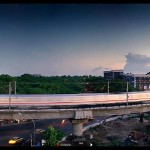Yahoo News
Indian naval exercises with Thailand and Indonesia are aimed in part at ensuring security for a new sea route linking the Indian and Pacific oceans, a top Indian general said.
Lieutenant-General Aditya Singh also said in an interview the military backs the idea of allowing foreign airlines at its airport in Port Blair, capital of the tsunami-struck Andaman and Nicobar islands, to boost tourism.
India held its first naval exercise last week with Thailand and concluded semi-annual exercises with Indonesia. Both took place near the mouth of the Malacca Strait, the main sea lane between the Indian Ocean and the South China Sea leading to the Pacific.
Although India is not party to any security arrangement for the Malacca Strait, the immediate purpose of the joint patrols is to prevent smuggling, piracy, drug and gun trafficking, poaching and illegal immigration in the region, Singh said.
“But the fact with things like the Kra canal, the Andaman and Nicobar islands will come into play,” he said.
Plans to dig a canal across the narrow Kra isthmus in southern Thailand have been bandied about for more than 300 years.
The idea has some support among Thai politicians but has stalled over the huge potential costs and environmental impact. A railroad to carry oil across the isthmus has also been discussed.
Singh, who visited tsunami-hit areas of Thailand last week with his Thai counterparts, did not disclose any knowledge of fresh plans for a Kra canal.
But a report prepared for U.S. Defense Secretary Donald Rumsfeld, leaked to the Washington Post in January, said China was willing to underwrite construction of the $20 billion canal, complete with port facilities, as part of its “string of pearls” strategy of forward bases and energy security.
“So then you have an alternate route for shipping,” Singh said in the interview held late on Wednesday at his headquarters atop a hill in Port Blair. “It will be like another Suez Canal.”
INTERNATIONAL FLIGHTS
Ships destined for the proposed 100-km (60-mile) Kra canal would have to pass through the channel between the Andaman and Nicobar island chains, he said.
“Now do you realise we will have a very large quantity of the world’s shipping going through? Apart from the economic value, there is going to be an increasing requirement to ensure security of the world’s shipping. And it is in this connection, that we are engaging our neighbours.
Oil-tanker traffic through the narrow Malacca Strait, which already carries most of North Asia’s oil imports, is projected to grow from 10 million barrels a day in 2002 to 20 million barrels a day in 2020 — much of it destined for China.
India began its “Look East” policy of engagement with its Southeast Asian neighbours in the 1990s, following the dissolution of the Soviet Union.
And while India’s ties with the United States have warmed considerably in recent years, New Delhi remains sensitive about U.S. presence in the Indian Ocean, Singh said.
Singh took up the post of commander-in-chief of the integrated army, air force and navy command in Andaman and Nicobar just after the Dec. 26 tsunami that killed 3,513 people and displaced nearly 40,000 on the islands about 1,200 kms from the Indian mainland.
He said the military no longer had concerns about letting foreign airlines land at Port Blair airport, which takes only flights from Chennai and Kolkata.
“There is no security problem, absolutely none. Let international flights land,” Singh said.
Port Blair’s problem is the lack of connections with other tourist spots in the region, such as Thailand’s Phuket island, a two-hour flight to the north.
“I can see in a year or two, from Singapore you can fly to Phuket and then on to Port Blair.”














